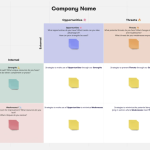Determining the target audience of a business is a crucial step in developing effective marketing strategies. By understanding who your target audience is, you can tailor your messaging and advertising efforts to reach the right people at the right time. In this article, we will explore various methods and strategies to determine the target audience of a business. We will also discuss the importance of staying updated with SEO trends and utilizing digital advertising to reach your target audience effectively.
Understanding the target audience is not just about knowing who they are, but also understanding their needs, preferences, and behaviors. This knowledge can help you create more effective marketing campaigns that resonate with your audience and drive conversions.
Understanding the Target Audience
Before diving into the methods of determining the target audience, it is essential to understand what a target audience is. The target audience refers to the specific group of people who are most likely to be interested in your products or services. These individuals share common characteristics, interests, and needs that align with what your business offers.
Identifying your target audience is crucial because it allows you to focus your marketing efforts on the people who are most likely to convert into customers. By understanding their preferences, behaviors, and demographics, you can create targeted marketing campaigns that resonate with them.
The Importance of a Target Audience
Understanding the importance of a target audience is the first step in determining who they are. A well-defined target audience can help you make informed decisions about your marketing strategies, product development, and customer service. It can also help you differentiate your business from competitors and create a unique brand identity.
Characteristics of a Target Audience
A target audience is characterized by specific demographics, psychographics, and behaviors. Demographics include factors like age, gender, income, and location, while psychographics refer to interests, attitudes, and lifestyle. Behavioral characteristics include purchasing habits, brand interactions, and online activity. Understanding these characteristics can help you create a detailed profile of your target audience.
Market Research
One of the most effective ways to determine your target audience is through market research. Market research involves gathering and analyzing data about your potential customers, competitors, and industry trends. This information can provide valuable insights into who your target audience is and what they are looking for.
There are several methods you can use to conduct market research:
Surveys and Questionnaires
Surveys and questionnaires are a popular method of gathering information about your target audience. You can create online surveys or distribute questionnaires to collect data on demographics, preferences, and buying behaviors. Analyzing the responses can help you identify patterns and trends among your target audience.

Focus Groups
Focus groups are another effective method for gathering insights about your target audience. By bringing together a small group of potential customers, you can gain direct feedback about your products, services, or marketing strategies. This can provide valuable insights into your target audience’s needs, preferences, and pain points.
Social Media Listening
Social media platforms provide a wealth of information about your target audience. By monitoring conversations, comments, and discussions related to your industry or products, you can gain insights into what your target audience is talking about, their pain points, and their preferences.
Online Analytics
Online analytics tools can provide valuable insights into your target audience’s online behavior. By analyzing data such as website visits, click-through rates, and social media engagement, you can gain a better understanding of your target audience’s interests and preferences.

Competitor Analysis
Analyzing your competitors can also provide valuable insights into your target audience. By studying their marketing strategies, messaging, and customer base, you can identify overlaps and gaps in the market. This information can help you refine your target audience and differentiate your business from competitors.
Industry Trends
Keeping an eye on industry trends can also help you determine your target audience. By understanding the latest trends and developments in your industry, you can anticipate changes in customer needs and preferences. This can help you stay ahead of the competition and attract more customers.
Utilizing SEO Trends
In today’s digital age, search engine optimization (SEO) plays a crucial role in reaching your target audience. SEO involves optimizing your website and content to rank higher in search engine results pages (SERPs). By staying updated with SEO trends, you can ensure that your business is visible to your target audience when they search for relevant keywords.
Here are some SEO trends to consider when determining your target audience:
Keyword Research
Keyword research is the process of identifying the keywords and phrases that your target audience is using to search for products or services similar to yours. By conducting keyword research, you can understand the language and terminology your target audience uses, allowing you to optimize your website and content accordingly.

Content Optimization
Content optimization involves creating high-quality, relevant content that resonates with your target audience. By incorporating your target keywords into your content, you can improve your website’s visibility in search engine results and attract more potential customers.
Voice Search Optimization
With the rise of voice assistants like Siri and Alexa, voice search has become increasingly popular. Optimizing your website and content for voice search can help you reach a broader audience. Consider the conversational nature of voice search queries and incorporate long-tail keywords and natural language into your content.
Local SEO
Local SEO is crucial for businesses that operate in specific geographic areas. By optimizing your website for local search, you can attract more customers in your local area. This involves using location-specific keywords, optimizing your Google My Business listing, and collecting customer reviews.
Mobile Optimization
As more people use their smartphones to browse the internet, mobile optimization has become essential. Ensure that your website is mobile-friendly and loads quickly on mobile devices. This will not only improve the user experience but also help your website rank higher in mobile search results.
User Experience Optimization
User experience (UX) is a crucial factor in SEO. A positive user experience can improve your website’s search engine rankings and attract more visitors. This involves ensuring that your website is easy to navigate, loads quickly, and provides valuable content to your visitors.
Leveraging Digital Advertising
Digital advertising is another powerful tool for reaching your target audience. With the ability to target specific demographics, interests, and behaviors, digital advertising allows you to deliver personalized messages to the right people at the right time.
Here are some digital advertising strategies to consider:
Social Media Advertising
Social media platforms like Facebook, Instagram, and Twitter offer robust advertising capabilities. You can create targeted ads based on demographics, interests, and behaviors. Additionally, social media platforms provide detailed analytics and insights, allowing you to track the performance of your ads and make data-driven decisions.
Video Advertising
Video advertising is a powerful way to engage your target audience. By creating compelling video content, you can capture your audience’s attention and convey your message effectively. Video ads can be shared on social media platforms, YouTube, or your website.
Display Advertising
Display advertising involves placing banner ads on websites and mobile apps. You can target specific websites or use programmatic advertising to reach your target audience across a network of websites. Display advertising allows you to create visually appealing ads that capture the attention of your target audience.
Email Marketing
Email marketing is a highly effective digital advertising strategy. By sending personalized emails to your target audience, you can build relationships, promote your products or services, and drive conversions. Email marketing allows you to reach your audience directly and deliver your message in a personal way.
Search Engine Advertising
Search engine advertising, also known as pay-per-click (PPC) advertising, allows you to display ads on search engine results pages. By bidding on keywords relevant to your business, you can ensure that your ads appear when people search for those keywords. This form of advertising is highly targeted and can drive qualified traffic to your website.
Retargeting
Retargeting is a digital advertising strategy that involves showing ads to people who have previously visited your website or interacted with your brand. This can help you stay top of mind with your target audience and encourage them to return to your website and make a purchase.
Conclusion
Determining the target audience of a business is a crucial step in developing effective marketing strategies. By conducting market research, staying updated with SEO trends, and leveraging digital advertising, you can reach your target audience effectively. Remember to continuously analyze and refine your target audience as your business evolves and market trends change. By understanding who your target audience is and what they are looking for, you can create personalized marketing campaigns that resonate with them and drive business growth.
Remember, the process of determining your target audience is not a one-time task. It requires continuous effort and adaptation as your business grows and evolves. By staying updated with the latest trends and changes in your industry, you can ensure that your marketing strategies remain effective and relevant.









